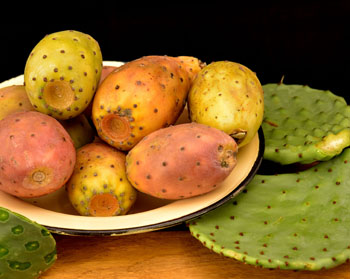
Cactus pear
Photo: Charl Devenish |
The dedicated research and development programme at the UFS on spineless cactus pear (Opuntia ficus-indica) – also known as prickly pear – has grown steadily in both vision and dimension during the past 15 years. Formal cactus pear research at the UFS started with the formation of the Prickly Pear Working Group (PPWG) in June 2002. It has since gone from strength to strength with several MSc dissertations and a PhD thesis as well as popular and scientific publications flowing from this initiative.
According to Prof Wijnand Swart from the Department of Plant Sciences, the UFS is today recognised as a leading institution in the world conducting multi-disciplinary research on spineless cactus pear.
Cactus pear for animal feed
Increasing demands on already scarce water resources in South Africa require alternative sources of animal feed – specifically crops that are more efficient users of water. One alternative with the potential for widespread production is spineless cactus pear. It is 1.14 x more efficient in its use of water than Old man saltbush, 2.8 x more efficient than wheat, 3.75 x more efficient than lucerne and 7.5 x more efficient than rangeland vegetation.
“Studies on the use of sun-dried cactus pear cladodes suggest that it has the potential to provide some 25% of the basic feed resources required by South Africa’s commercial ruminant feed manufacturing sector,” says Prof HO de Waal of the Department of Animal, Wildlife and Grassland Sciences at the UFS.
Until recently, research has focused extensively on the use of cactus pear as drought fodder. However, this is now beginning to shift, with growing interest in the intensive production of spineless cactus pear for other types of animal feed. One example is the spineless cactus pear fruit, produced seasonal, yielding large quantities of fruit in a relatively short period of a few months in summer. Unless kept in cold storage, the fruit cannot be stored for a long period. Therefore, a procedure was developed to combine large volumes of mashed cactus pear fruit with dry hay and straw and preserve it for longer periods as high moisture livestock feed, kuilmoes – a high water content livestock feed similar to silage.

Cactus pear and Pineapple juice
Photo: Charl Devenish |
Cactus pear for human consumption
“In addition to its use as a livestock feed, cactus pear is increasingly being cultivated for human consumption. Although the plant can be consumed fresh as a juice or vegetable, significant value can be added through processing. This potential is considerable: the plant can be pickled; preserved as a jam or marmalade; or dried and milled to produce baking flour. It can also serve as a replacement of egg and fat in mayonnaise,” said Dr Maryna de Wit from the Department of Microbial, Biochemical and Food Biotechnology.
The extraction of mucilage from fresh cladodes can form a gelling, emulsifier, and fat-replacing agent commonly found in food products such as mayonnaise and candy. During an information session to the media Dr De Wit and her team conducted a food demonstration to showcase the use of the cladodes in a juice, chicken stir-fry, biscuits and a salad.
The extrusion of cactus pear seed oil provides a further lucrative niche product to the array of uses. These include high-value organic oil for the cosmetic sector, such as soap, hair gel and sun screens.
The cladodes and the fruit also have medicinal uses. It has anti-viral, anti-inflammatory, pain killing and anti-diabetic agents. It is also high in fibre and can lower cholesterol. The fruit also prevents proliferation of cells and suppresses tumour growth and can even help to reduce a hangover.
In South Africa the outdated perception of cactus pears as thorny, alien invaders, is rapidly disappearing. Instead, farmers now recognise that cactus pear can play a vital role as a high yielding, water-efficient, multi-use crop, said Prof de Waal and the members of the Cactus Pear Team.
Facebook photo gallery
Dagbreek interview with Dr Maryna de Wit
Research on cactus pear (read the full story)
For more information or enquiries contact news@ufs.ac.za